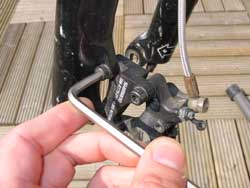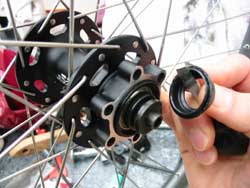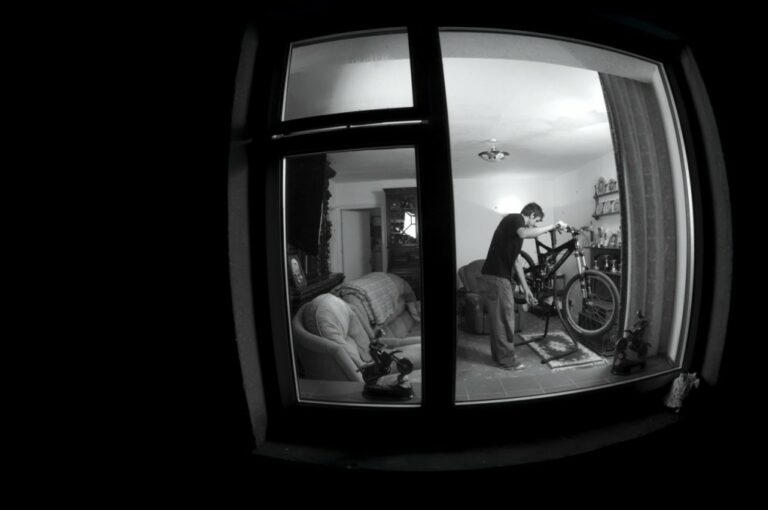It’s easy to forget about your bottom bracket. It’s hidden away in the frame, all but invisible. The only time it makes its presence felt is when it starts to tire of the endless rotations and decides to experiment with creaks, grinds, rattles and movement in hitherto unexplored directions. None of this is good. Once upon a time, all bottom brackets were adjustable cup-and-cone affairs that could be stripped, cleaned, regreased, refitted and readjusted. All of which was as much of a faff as it sounds. These days most BBs are fit-and-forget affairs, until they die at which point you chuck ’em and put another one in. Here’s how…
We’re looking at Shimano bottom brackets here, the most common type. Most others work on the same principes, although some exotic ones have their own installation nuances – if you’ve got one of those, refer to the instructions that came with it.
This is a pretty messy job. In addition, have a couple of rags to hand for wiping things with, otherwise your trousers are never going to be the same again.
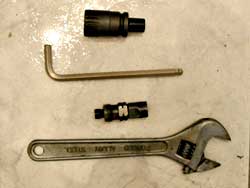 A simple selection of tools. You’ll need a crank extractor to suit your cranks, a bottom bracket tool to suit your bottom bracket, a big spanner to drive them with and whatever Allen key or socket you need to undo and tighten the crank bolts.
A simple selection of tools. You’ll need a crank extractor to suit your cranks, a bottom bracket tool to suit your bottom bracket, a big spanner to drive them with and whatever Allen key or socket you need to undo and tighten the crank bolts.
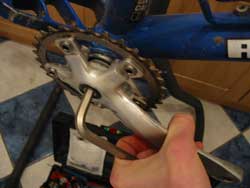 The first step is to take the cranks off.
The first step is to take the cranks off.
 With the cranks off, it’s time to turn our attention to the BB itself. They’re in two parts, with the bearing unit and axle permanently attached to a threaded cup on the drive-side and a removable cup to go in the non-drive-side. The cups screw into threads cut into the bottom bracket shell on the frame. To undo them, you’ll need a suitable BB tool to engage in the splines inside the cup.
With the cranks off, it’s time to turn our attention to the BB itself. They’re in two parts, with the bearing unit and axle permanently attached to a threaded cup on the drive-side and a removable cup to go in the non-drive-side. The cups screw into threads cut into the bottom bracket shell on the frame. To undo them, you’ll need a suitable BB tool to engage in the splines inside the cup.
 Start with the non-drive-side. Push the BB tool into the splines and turn it anti-clockwise. Some BB tools require you to use a spanner, some have a hole to put an Allen key in the end and some have a standard square-drive fitting that you can fit a torque wrench or ratcheting socket handle thing into. If the BB’s been in a while, there’s a fair chance it’ll be hard to shift. You can get extra oomph by aligning whatever handle you’re using slightly lower than the bike’s chainstay and squeezing the handle and the chainstay together with one hand. Use the other hand to stop the BB tool falling out of the end of the bottom bracket.
Start with the non-drive-side. Push the BB tool into the splines and turn it anti-clockwise. Some BB tools require you to use a spanner, some have a hole to put an Allen key in the end and some have a standard square-drive fitting that you can fit a torque wrench or ratcheting socket handle thing into. If the BB’s been in a while, there’s a fair chance it’ll be hard to shift. You can get extra oomph by aligning whatever handle you’re using slightly lower than the bike’s chainstay and squeezing the handle and the chainstay together with one hand. Use the other hand to stop the BB tool falling out of the end of the bottom bracket.
 The drive-side is almost the same except for one key difference – it unscrews clockwise. This is thanks to the wonders of bearing precession, which would tend to make the drive-side cup unscrew itself as you pedalled along if it was threaded the usual way. Don’t worry about the whys and wherefores, though – just remember that it’s back-to-front. If it’s really hard to undo there’s a good chance that you’re actually trying to tighten it up…
The drive-side is almost the same except for one key difference – it unscrews clockwise. This is thanks to the wonders of bearing precession, which would tend to make the drive-side cup unscrew itself as you pedalled along if it was threaded the usual way. Don’t worry about the whys and wherefores, though – just remember that it’s back-to-front. If it’s really hard to undo there’s a good chance that you’re actually trying to tighten it up…
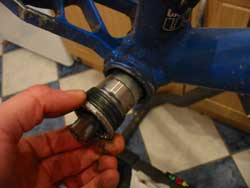 Once it’s undone, the whole assembly will come out in one piece. Put it to one side and lob it in the scrap metal skip at your nearest tip next time you’re down there, pausing only to check the dimensions so you can get another one with the same shell width and axle length. The safest bet if you’re not sure is to take the old one to the shop and ask for another one exactly the same. But less knackered, obviously.
Once it’s undone, the whole assembly will come out in one piece. Put it to one side and lob it in the scrap metal skip at your nearest tip next time you’re down there, pausing only to check the dimensions so you can get another one with the same shell width and axle length. The safest bet if you’re not sure is to take the old one to the shop and ask for another one exactly the same. But less knackered, obviously.
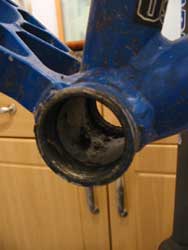 Take a shufti at the now-empty bottom bracket shell on your frame. There’s a high probability that it’s full of soil or water or flourishing ecosystems or even quite advanced civilisations depending on how long it’s been there. Clean it all out and make sure there’s no grit, swarf or anything else in the threads.
Take a shufti at the now-empty bottom bracket shell on your frame. There’s a high probability that it’s full of soil or water or flourishing ecosystems or even quite advanced civilisations depending on how long it’s been there. Clean it all out and make sure there’s no grit, swarf or anything else in the threads.
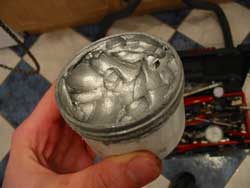 Say hello to Mr Anti-Sieze (or his close relative Mr Copper-Slip). This is essential in the world of bottom brackets. A good slathering of this stuff on the BB threads will considerably increase your chances of ever getting the thing out again. This will be music to your ears if you’ve just sustained two handfuls of barked knuckles trying to remove the old one. If you haven’t got any, go get some. If you haven’t got any and the shops are shut and you absolutely have to get your bike back together right now for a ride first thing in the morning (we’ve all been there…), use grease for now but redo it with anti-sieze when you have the chance.
Say hello to Mr Anti-Sieze (or his close relative Mr Copper-Slip). This is essential in the world of bottom brackets. A good slathering of this stuff on the BB threads will considerably increase your chances of ever getting the thing out again. This will be music to your ears if you’ve just sustained two handfuls of barked knuckles trying to remove the old one. If you haven’t got any, go get some. If you haven’t got any and the shops are shut and you absolutely have to get your bike back together right now for a ride first thing in the morning (we’ve all been there…), use grease for now but redo it with anti-sieze when you have the chance.
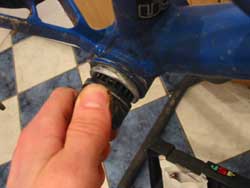 In best Haynes manual tradition, Refitting Is The Reverse Procedure As Removal. Coat the new BB drive-side threads with anti-sieze and thread it into the shell. Remember it threads in anti-clockwise. The key thing is to keep the unit aligned so it threads in straight – getting it cross-threaded is bad news, particularly on an aluminium frame… If you’re having trouble getting the thread started, turn it slowly the wrong way while applying gentle inwards pressure. At some point it’ll clonk in to the start of the thread and you can start turning it the right way. You should be able to drive it most of the way in just by hand – if it takes more effort, something’s wrong. Use something with a bit of leverage to snug it home. It’s obvious when it’s in, it suddenly stops turning.
In best Haynes manual tradition, Refitting Is The Reverse Procedure As Removal. Coat the new BB drive-side threads with anti-sieze and thread it into the shell. Remember it threads in anti-clockwise. The key thing is to keep the unit aligned so it threads in straight – getting it cross-threaded is bad news, particularly on an aluminium frame… If you’re having trouble getting the thread started, turn it slowly the wrong way while applying gentle inwards pressure. At some point it’ll clonk in to the start of the thread and you can start turning it the right way. You should be able to drive it most of the way in just by hand – if it takes more effort, something’s wrong. Use something with a bit of leverage to snug it home. It’s obvious when it’s in, it suddenly stops turning.
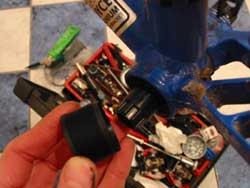 With the drive-side fully home, turn your attention to the non-drive-side cup. On cheaper bottom brackets this’ll be plastic so you can get away without anti-sieze. The alloy ones on more expensive units will need the full treatment, though. In both cases a dab of grease inside helps. Thread the cup in to the non-drive side. Again, it shouldn’t take undue effort. Keep winding until it won’t go in any further. Don’t worry if the cup isn’t exactly flush with the outside of the BB shell, there’s often a couple of mm sticking out. If there’s loads of excess or it disappears inside the shell you may have the wrong width BB for your frame.
With the drive-side fully home, turn your attention to the non-drive-side cup. On cheaper bottom brackets this’ll be plastic so you can get away without anti-sieze. The alloy ones on more expensive units will need the full treatment, though. In both cases a dab of grease inside helps. Thread the cup in to the non-drive side. Again, it shouldn’t take undue effort. Keep winding until it won’t go in any further. Don’t worry if the cup isn’t exactly flush with the outside of the BB shell, there’s often a couple of mm sticking out. If there’s loads of excess or it disappears inside the shell you may have the wrong width BB for your frame.
 All that remains now is to put a bit of grease on the ends of the BB axle, push the crankarms on, grease the bolts and tighten them up. And that should be that for the next six months at least…
All that remains now is to put a bit of grease on the ends of the BB axle, push the crankarms on, grease the bolts and tighten them up. And that should be that for the next six months at least…

